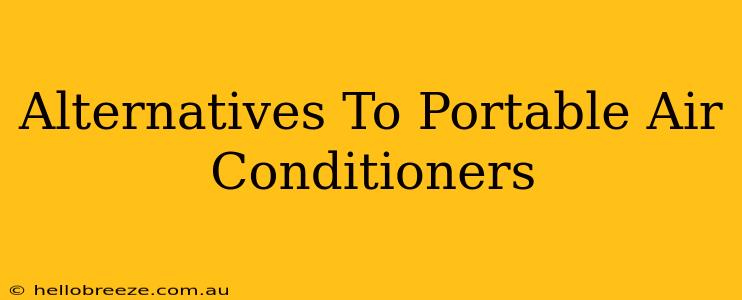Portable air conditioners are convenient, but they come with drawbacks: they're bulky, expensive, and can be inefficient. If you're looking for ways to cool down your space without resorting to a portable AC unit, you've come to the right place. This guide explores effective and affordable alternatives to help you stay cool all summer long.
Embrace Natural Cooling Solutions
Before investing in any technology, consider the power of nature. These methods are environmentally friendly and cost-effective:
Open Windows Strategically:
This might seem obvious, but opening windows at the right time can make a big difference. Open windows during cooler parts of the day (usually early morning and evening) to let in a refreshing breeze. Close them during the hottest parts of the day to keep the heat out. Consider cross-ventilation – opening windows on opposite sides of your room to create airflow.
Utilize Fans Effectively:
Fans are a fantastic, energy-efficient alternative to air conditioners. A ceiling fan, strategically placed, can create a noticeable difference in temperature. For smaller spaces, a desk or floor fan can provide targeted cooling. Remember to use fans in conjunction with other cooling methods for optimal results. Pro Tip: Place a bowl of ice water in front of a fan to create an evaporative cooling effect.
Embrace the Shade:
Direct sunlight significantly increases the temperature of your home. Close curtains, blinds, or shades during the day to block out the sun's rays and keep your space cooler. Consider installing reflective window film to further reduce solar heat gain.
Energy-Efficient Cooling Technologies
If natural methods aren't enough, consider these energy-efficient cooling alternatives:
Window Air Conditioners:
While not as portable, window air conditioners are generally more efficient and less expensive than portable units. They directly cool the room they're installed in, unlike portable ACs which can lose cool air through the exhaust hose. They are a more permanent solution, but offer superior cooling power for the price.
Evaporative Coolers (Swamp Coolers):
These are particularly effective in dry climates. They work by evaporating water, which cools the air. They're much more energy-efficient than air conditioners, but may not be as effective in humid environments.
Ventilation Systems:
Investing in a whole-house ventilation system can significantly improve air circulation and reduce indoor temperatures. These systems draw in cool outside air and exhaust warm stale air, creating a more comfortable environment. This is a long-term investment that improves both comfort and air quality.
Lifestyle Changes for a Cooler Home
Sometimes, simple lifestyle changes can make a world of difference:
Light Clothing and Hydration:
Wear light-colored, loose-fitting clothing to stay cool. Staying well-hydrated is crucial during hot weather. Drink plenty of water throughout the day.
Cook Smart:
Avoid using the oven or stovetop during the hottest parts of the day to minimize heat buildup in your home. Opt for no-cook meals or use a slow cooker or microwave instead.
Consider Your Bedding:
Use lightweight bedding such as cotton sheets and a thin blanket to stay comfortable at night.
Conclusion: Finding the Right Cooling Solution
The best alternative to a portable air conditioner depends on your specific needs, budget, and climate. By combining natural cooling methods with energy-efficient technologies and simple lifestyle adjustments, you can effectively beat the heat without the bulk and expense of a portable AC unit. Remember to always prioritize energy efficiency and environmental consciousness when choosing your cooling solution.

